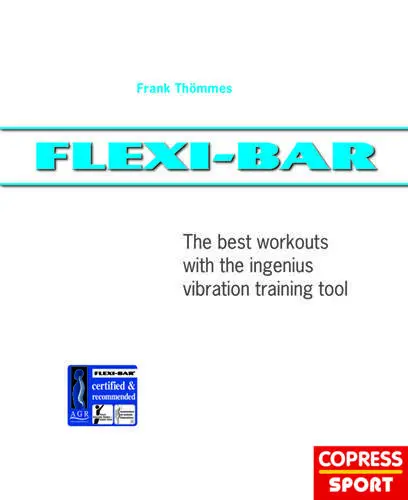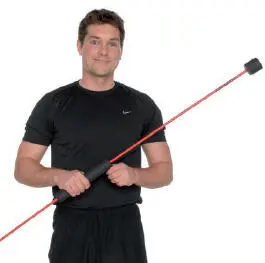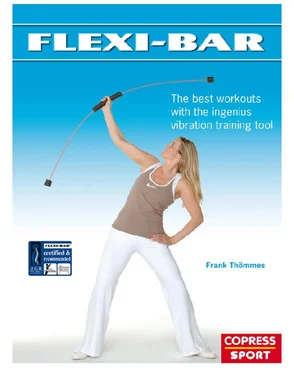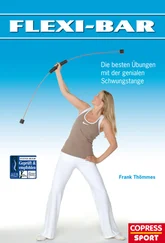
Frank Thömmes, born in 1968, is a graduate PE teacher, soccer and back training teacher, as well as head in coronary sports exercises. He has numerous trainer and advanced vocational qualifications at his disposal in the field of some sport disciplines, as well as additional therapeutic qualifications.
As an author, he wrote several publications about the exercise with the FLEXI-BAR and the »XCO-Trainer,« as well as articles about workplace health promotion.
His agency, www.fit-projects.de, organises health and exercise projects for health insurances and other clients throughout Germany.

Copyright
Cover Design:
Stiebner Verlag
Photos:
Stefan Wengert; FLEXI-SPORTS
Translation:
Lisa Buckmiller
Illustrations:
Anneli Nau; Frank Geisler
FLEXI-BAR and the FLEXI-BAR logo are registered trademarks of the FLEXI-SPORTS GmbH. The use in this book takes place with friendly approval of the FLEXI-SPORTS GmbH.
Source of Supply, Links, Community:
www.flexi-sports.com
www.flexi-bar.co.uk
www.fit-projects.de
www.mach-aktiv-pause.de
www.xco-trainer.de
www.fit-xco.de
www.agr-ev.de
Note about the AGR-seal of quality:
Checked and recommended through the Forum: Gesunder Rücken – besser leben e. V. and the Bundesverband der deutschen Rückenschulen (BdR) e. V.
Further information at:
AGR e.V., Pf. 103, 27443 Selsingen,
Tel. 04284/92 69 990, www.agr-ev.de
The advices in this work are carefully considered and checked by the author. For correctness in the details, however, the author or rather the publishing house and its representatives cannot incur liability.
© 2011 Copress Verlag
in the Stiebner Verlag GmbH, München
All rights reserved.
Reproduction, also in form of exerpts,
only with explicit approval of the publishing house.
Total production:
Stiebner, München
Printed in Germany
ISBN 978-3-7679-1125-3
www.copress.de
A healthy person has no clue how much wealth that is.
About this Book About this Book For more than 15 years, I have been working within the scope of by now over 1000 prevention classes with patients who seek professional help dealing with back problems. During my sports studies, I already got to know the complexity and the individual fates connected to it. In the course of my education in becoming one of Germany’s first teachers for back training and later as an instructor for the Forum Gesunder Rücken – besser leben e.V., I also became aware of the discrepancy between modern and seemingly out-of-date ways of therapy approaches for back problems. Considering exercise as a measurement of all things when it comes to prevention and therapy of back pain, still has not been put into practice. After such a long time, it very well should be permitted to ask what the problem seems to be: even today I am still confronted over and over again with patients whose doctors only know about the therapy order of injection, pills and rest. Exercise is rarely recommended, and often it simply seems to be too late or too expensive to take deconditioning steps against the pain cycle through exercise therapy. In search of practical assistance for affected persons and of feasible programs to pursue oneself, the FLEXI-BAR came to my attention years ago already, and I have ever since regularly used it in every group. The simplicity of the operation, the complexity in its effect, the positive results in strength, reflex control, and coordination, as well as the applicability in self-training at home combined with short duration of exercise, proved to be a logical concept with a widespread impact on back problems. For these reasons, I have tried to take a closer look at the whole topic of »training with dynamic bars and vibration« in the current book. However, the more closely I did my research and reinforced the topic, the more I reached the convictions that the topic is perfectly depicted through the FLEXI-BAR and the accompanying concept. Thus, the book came to its title. Shortly before the printing of this book, a large grocery discount store included a low-priced model of a dynamic bar in their product line – a further indicator for the increasing interest in this concept of training. Every reader is welcome to try reaching the described effects with any model of a dynamic bar or rather to perform the introduced exercises. Mind you that I do not recommend this, but it would be possible. In my experience, most users will end up with the FLEXI-BAR, which I still use in all classes, from competitive sport over sport for seniors, all the way to therapy. Have fun with swinging! Frank Thömmes, autumn 2011
The Development of Vibration Exercise 1 The Development of Vibration Exercise
The History of Dynamic Bars The History of Dynamic Bars How old the idea of a flexible dynamic bar held in one’s hand really is, cannot be exactly determined. Therapeutic and scientific efforts have equally influenced the effect of the transfer of vibration by means of dynamic bars to the human body, and both have left their mark on different developments. An end to these efforts cannot be expected yet, since more and more vibration devices are getting invented and developed. The »Propriomed,« a dynamic bar, and the »Posturomed,« a vibrating floor space, took a root on the therapeutic level. On the huge market of fitness home equipment and accommodations, however, only the FLEXI-BAR, which developed into the only dynamic bar with broad acceptance, accomplished this. The FLEXI-BAR is more than a trend though, due to the constantly increasing ways of use and the perceiving of the mode of action of the swinging bar of more and more groups of people.
Starting Point Vibration Exercise and Physical Therapy Starting Point Vibration Exercise and Physical Therapy Vibration exercise means in a more narrow sense a form of exercise in which the performer stands on a vibrating disc or a vibrating subsoil. Thereby, the vibration hits the body from the bottom up. The goal of this form of exercise is the stimulation of stretching reflexes in a high number and the contractions of muscles related to that. During the likewise known biomechanic stimulation (BMS), individual groups of muscles are locally affected through attached vibration devices. The promised results of these reach from pain reduction for patients to increased performance for athletes. Vibrating medical auxiliary tools go back farther in their tradition. In the 19th century already, patients with back pain in the USA were cured with vibration devices, and vibrating chairs were tested as a treatment for patients with Parkinson. In a large number, these devices mainly operated through steam, were also to be found in Europe. The publication by Doctor Biermann, which describes the effect of cyclic oscillation (swinging) on the human body, dates back to 1960. In 1970, the idea found its entrance to the field of sports. Nazarow, a Russian physician, established the biomechanical stimulation (BMS) as a method of exercise for the gymnastics squad of the Soviet Union at the time. This method is still in practical use today. Since the beginning of the new millenium, there are more and more producers offering vibrating platforms and dynamic bars for the fitness market. The effect of vibration exercise has not been verified sufficiently by science yet. Studies exist, which were frequently carried out on non-athletes. This favours good results. Furthermore, there are numerous non-scientific studies with contradicting results, usually carried out on very small groups of patients.
Читать дальше














